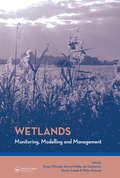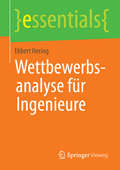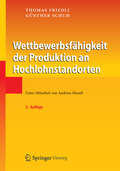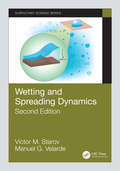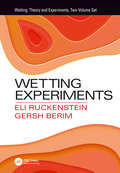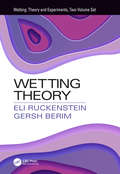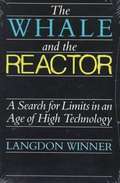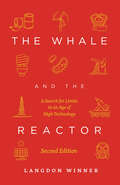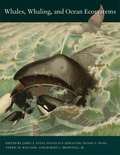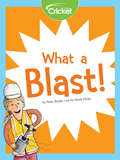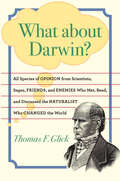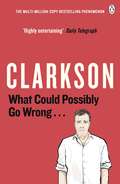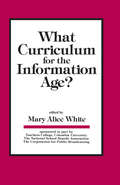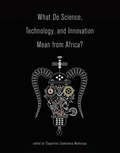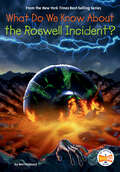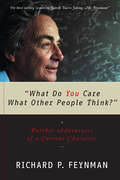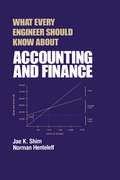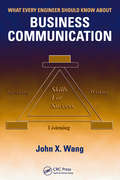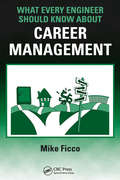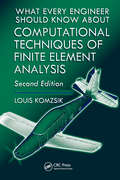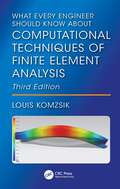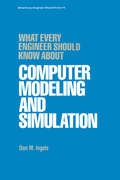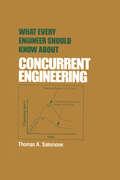- Table View
- List View
Wetlands: Monitoring, Modelling and Management
by Tomasz Okruszko Edward Maltby Jan Szatyłowicz Dorota Świątek Wiktor KotowskiWetlands are complex and dynamic ecological systems incorporating two important, inter-linked components: hydrology and vegetation. Modelling wetland components and processes reveals the nature of wetland systems and helps to predict the effects of environmental change. The main goal of much current research is the construction of a vigorous and sp
Wettbewerbsanalyse für Ingenieure (essentials)
by Ekbert HeringEine Wettbewerbsanalyse untersucht systematisch die Stärken und die Schwächen des eigenen Unternehmens in Bezug auf die maßgeblichen Wettbewerber. Ist die eigene Position relativ zu den Wettbewerbern bekannt, so kann durch bestimmte Maßnahmen eine Stärkung der relativen Wettbewerbsfähigkeit erreicht werden. Ausgehend vom Porter´schen Ansatz der wirkenden Wettbewerbskräfte im Markt werden die Chancen und Gefahren sowie die Stärken und Schwächen des betrachteten Unternehmens relativ zu den Wettbewerbern bestimmt. Mit Hilfe von strategischen Karten und die Visualisierung mit Hilfe von Gefahrenkreise der fünf Wettbewerbskräfte sowie der Portfolio-Technik kann die Bedrohungsgefahr unmittelbar erkannt werden. Dadurch können gezielt Maßnahmen zur Steigerung der Wettbewerbsfähigkeit von Produkten und Dienstleistungen von Unternehmen eingeleitet werden. Diese erhöhen den Erfolg (d. h. Umsatz und Ertrag) des Unternehmens.
Wettbewerbsfähigkeit der Produktion an Hochlohnstandorten
by Günther Schuh Thomas FriedliIn einem dynamischer und komplexer werdenden Umfeld wird produzierenden Unternehmen mehr und mehr Flexibilität abverlangt. Die Autoren stellen einen integrierten Managementansatz mit spezifischen Methoden und Instrumente vor, mit denen Unternehmen zur notwendigen Flexibilität geführt werden können. Der St. Galler Tradition folgend, steht dabei nicht die Teiloptimierung einzelner Bereiche, sondern die Betrachtung des Gesamtunternehmens im Vordergrund. In der 2. Auflage werden neue Ansätze erläutert, u. a. Globale Produktion und Operative Exzellenz.
Wetting and Spreading Dynamics, Second Edition (Surfactant Science #12)
by Victor M. Starov Manuel G. VelardeThis book explains how surface forces acting at the three-phase contact line determine equilibrium, hysteresis contact angles, and other equilibrium and kinetics features of liquids when in contact with solids or other immiscible liquids. It examines the interaction of surface forces, capillary forces, and properties of the transition zone between the bulk liquid and solid substrate. New chapters cover spreading of non-Newtonian liquids over porous substrates, hysteresis of contact angles on smooth homogeneous substrates, equilibrium and hysteresis contact angles on deformable substrates, and interaction of foams with porous substrates. Written for both newcomers and experienced researchers.
Wetting Experiments
by Eli Ruckenstein Gersh BerimWetting Experiments contains experimental wetting studies related to biological problems, polymers, and catalysts. An understanding of wetting is important for numerous practical applications, such as preparing self-cleaning surfaces, manufacturing artificial blood vessels, and developing new lubricants and nonadhesive dishes. As part of Wetting: Theory and Experiments, Two-Volume Set, this volume provides new insights into wetting experiments and fills a need not addressed by other books. Biology-related studies are devoted to the problem synthetic materials selection for use in biological media. Polymers are examined to estimate various surface characteristics, such as the ability of polymeric solids to alter their surface structures between different environments to minimize their interfacial free energy. Aimed at engineers, physical scientists, and materials scientists, this volume addresses the key areas of wetting, providing insights valuable to the field.
Wetting Theory
by Eli Ruckenstein Gersh BerimWetting Theory discusses the numerous practical applications of wetting, such as preparing self-cleaning surfaces, manufacturing artificial blood vessels, and developing new lubricants and nonadhesive dishes. As part of Wetting: Theory and Experiments, Two-Volume Set, this volume provides new, critical insights into the theory of wetting. Chapters are arranged to allow readers to follow the development of a suggested approach (static and dynamic properties of wetting) and how these tools are applied to specific problems. Main attention is given to nanoscale wetting (nanodrops on solid surfaces, liquid in the nanoslit) on the basis of microscopic density functional theory and fluid dynamics on solid surfaces on the basis of hydrodynamic equations. Aimed at engineers, physical scientists, and materials scientists, this volume addresses the key areas of wetting, providing invaluable insights to the field.
The Whale and the Reactor: A Search for Limits in an Age of High Technology
by Langdon Winner"The questions he poses about the relationship between technical change and political power are pressing ones that can no longer be ignored, and identifying them is perhaps the most a nascent 'philosophy of technology' can expect to achieve at the present time. "—David Dickson, New York Times Book Review "The Whale and the Reactor is the philosopher's equivalent of superb public history. In its pages an analytically trained mind confronts some of the most pressing political issues of our day. "—Ruth Schwartz Cowan, Isis
The Whale and the Reactor: A Search for Limits in an Age of High Technology, Second Edition
by Langdon Winner“In an age in which the inexhaustible power of scientific technology makes all things possible, it remains to be seen where we will draw the line, where we will be able to say, here are possibilities that wisdom suggest we avoid.” First published to great acclaim in 1988, Langdon Winner’s groundbreaking exploration of the political, social, and philosophical implications of technology is timelier than ever. He demonstrates that choices about the kinds of technical systems we build and use are actually choices about who we want to be and what kind of world we want to create—technical decisions are political decisions, and they involve profound choices about power, liberty, order, and justice. A seminal text in the history and philosophy of science, this new edition includes a new chapter, preface, and postscript by the author.
Whales, Whaling, and Ocean Ecosystems
by Douglas P. Demaster Daniel F. Doak Terrie M. Williams Robert L. Brownell Jr. James A. EstesThis unprecedented volume presents a sweeping picture of what we know about the natural history, biology, and ecology of whales in the broad context of the dynamics of ocean ecosystems. Innovative and comprehensive, the volume encompasses multiple points of view to consider the total ecological impact of industrial whaling on the world's oceans. Combining empirical research, ecological theory and modeling, and historical data, its chapters present perspectives from ecology, population biology, physiology, genetics, evolutionary history, ocean biogeography, economics, culture, and law, among other disiplines. Throughout, contributors investigate how whaling fundamentally disrupted ocean ecosystems, examine the various roles whales play in food webs, and discuss the continuing ecological chain reactions to the depletion of these large animals. In addition to reviewing what is known of the current and historic whale populations, Whales, Whaling, and Ocean Ecosystems considers how this knowledge will bear on scientific approaches to conservation and whaling in the future and provocatively asks whether it is possible to restore ocean ecosystems to their pre-whaling condition.
Whaling and International Law
by Malgosia FitzmauriceWhales are regarded as a totemic symbol by some nations and as a natural marine resource by others. This book presents a complex picture of legal problems surrounding the interpretation of the International Convention for the Regulation of Whaling and the role of its regulatory body, the International Whaling Commission. Contemporary whaling is about the competing interests of whaling nations (which are in the minority), non-whaling nations (which are in the majority) and indigenous peoples. Whales are covered by many international conventions, which has led to a very fragmented legal situation and does not necessarily ensure that whales are protected. This is one of the paradoxes of the contemporary international legal regime which are explored in this book. The book also examines the contentious issue of the right of indigenous peoples to whaling and questions whether indigenous whaling is very different from commercial practices.
What a Blast!
by Peter BanksKaboom! Find out how explosions are used to demolish large buildings. Demolition experts say it's the safest way. Learn why!
What about Darwin?: All Species of Opinion from Scientists, Sages, Friends, and Enemies Who Met, Read, and Discussed the Naturalist Who Changed the World
by Thomas F. Glick2010 Outstanding Academic Title, Choice MagazineCharles Darwin and his revolutionary ideas inspired pundits the world over to put pen to paper. In this unique dictionary of quotations, Darwin scholar Thomas Glick presents fascinating observations about Darwin and his ideas from such notable figures as P. T. Barnum, Anton Chekhov, Mahatma Gandhi, Carl Jung, Martin Luther King, Mao Tse-tung, Pius IX, Jules Verne, and Virginia Woolf. What was it about Darwin that generated such widespread interest? His Origin of Species changed the world. Naturalists, clerics, politicians, novelists, poets, musicians, economists, and philosophers alike could not help but engage his theory of evolution. Whatever their view of his theory, however, those who met Darwin were unfailingly charmed by his modesty, kindness, honesty, and seriousness of purpose. This diverse collection drawn from essays, letters, novels, short stories, plays, poetry, speeches, and parodies demonstrates how Darwin’s ideas permeated all areas of thought. The quotations trace a broad conversation about Darwin across great distances of time and space, revealing his profound influence on the great thinkers of the nineteenth and twentieth centuries.
What Can a Body Do?: How We Meet the Built World
by Sara HendrenA fascinating and provocative new way of looking at the things we use and the spaces we inhabit, and a call to imagine a better-designed world for us all.Furniture and tools, kitchens and campuses and city streets—nearly everything human beings make and use is assistive technology, meant to bridge the gap between body and world. Yet unless, or until, a misfit between our own body and the world is acute enough to be understood as disability, we may never stop to consider—or reconsider—the hidden assumptions on which our everyday environment is built. In a series of vivid stories drawn from the lived experience of disability and the ideas and innovations that have emerged from it—from cyborg arms to customizable cardboard chairs to deaf architecture —Sara Hendren invites us to rethink the things and settings we live with. What might assistance based on the body&’s stunning capacity for adaptation—rather than a rigid insistence on &“normalcy&”—look like? Can we foster interdependent, not just independent, living? How do we creatively engineer public spaces that allow us all to navigate our common terrain? By rendering familiar objects and environments newly strange and wondrous, What Can a Body Do? helps us imagine a future that will better meet the extraordinary range of our collective needs and desires.
What Could Possibly Go Wrong. . .
by Jeremy ClarksonWhat Could Possibly Go Wrong... is the sixth book in Jeremy Clarkson's bestselling The World According to Clarkson series.No one writes about cars like Jeremy Clarkson. While most correspondents are too buys diving straight into BHP, MPG and MPH, Jeremy appreciates that there are more important things to life. Don't worry, we'll get to the cars. Eventually. But first we should consider: · The case for invading France · The overwhelming appeal of a nice sit-down · The inconvenience of gin and tonic · Why clothes are no better than ice cream · Spot-welding with the Duchess of Kent · And why Denmark is the best place in the world Armed only with conviction, curiosity, enthusiasm and a stout pair of trousers, Jeremy hurtles around the world - along motorway, autoroute, freeway and autobahn - in search of answers to life's puzzles and ponderings without forethought or fear for his own safety. What, you have to ask, could possibly go wrong...Praise for Clarkson:'Brilliant... laugh-out-loud' Daily Telegraph'Outrageously funny... will have you in stitches' Time Out'Very funny . . . I cracked up laughing on the tube' Evening StandardJeremy Clarkson began his career on the Rotherham Advertiser. Since then he has written for the Sun, theSunday Times, the Rochdale Observer, the Wolverhampton Express & Star, all of the Associated Kent Newspapers and Lincolnshire Life. Today he is the tallest person working in British television.
What Curriculum for the Information Age
by Mary Alice WhiteFirst Published in 1987. Routledge is an imprint of Taylor & Francis, an informa company.
What Do Science, Technology, and Innovation Mean from Africa? (The\mit Press Ser.)
by Clapperton MavhungaExplorations of science, technology, and innovation in Africa not as the product of “technology transfer” from elsewhere but as the working of African knowledge.In the STI literature, Africa has often been regarded as a recipient of science, technology, and innovation rather than a maker of them. In this book, scholars from a range of disciplines show that STI in Africa is not merely the product of “technology transfer” from elsewhere but the working of African knowledge. Their contributions focus on African ways of looking, meaning-making, and creating. The chapter authors see Africans as intellectual agents whose perspectives constitute authoritative knowledge and whose strategic deployment of both endogenous and inbound things represents an African-centered notion of STI. “Things do not (always) mean the same from everywhere,” observes Clapperton Chakanetsa Mavhunga, the volume's editor. Western, colonialist definitions of STI are not universalizable.The contributors discuss topics that include the trivialization of indigenous knowledge under colonialism; the creative labor of chimurenga, the transformation of everyday surroundings into military infrastructure; the role of enslaved Africans in America as innovators and synthesizers; the African ethos of “fixing”; the constitutive appropriation that makes mobile technologies African; and an African innovation strategy that builds on domestic capacities. The contributions describe an Africa that is creative, technological, and scientific, showing that African STI is the latest iteration of a long process of accumulative, multicultural knowledge production.ContributorsGeri Augusto, Shadreck Chirikure, Chux Daniels, Ron Eglash, Ellen Foster, Garrick E. Louis, D. A. Masolo, Clapperton Chakanetsa Mavhunga, Neda Nazemi, Toluwalogo Odumosu, Katrien Pype, Scott Remer
What Do We Know About the Roswell Incident? (What Do We Know About?)
by Ben Hubbard Who HQThe What Do We Know About? series explores the mysterious, the unknown, and the unexplained. Will we ever learn the truth about what actually landed at Roswell? From the #1 New York Times Best-Selling Who Was? series comes Where Is?, a series that tells the stories of world-famous landmarks and natural wonders and features a fold-out map!In 1947, an unusual object crashed in the New Mexico desert and was recovered by the Roswell Army Airfield officers. People everywhere began to speculate what the object could be. Could it possibly be a flying saucer? Would that be proof of aliens and life beyond Earth? Even decades later, some people still believe that the Roswell Incident is the most famous UFO sighting ever. Still, those who worked at the airfield insist it was just a weather balloon that had fallen from the sky. Was the Roswell Incident evidence of alien life, a government cover-up, or just a myth? Here are the facts about what we do know about Roswell.
"What Do You Care What Other People Think?": Further Adventures of a Curious Character
by Ralph Leighton Richard P. FeynmanThe New York Times best-selling sequel to "Surely You're Joking, Mr. Feynman!" One of the greatest physicists of the twentieth century, Richard Feynman possessed an unquenchable thirst for adventure and an unparalleled ability to tell the stories of his life. "What Do You Care What Other People Think?" is Feynman's last literary legacy, prepared with his friend and fellow drummer, Ralph Leighton. Among its many tales--some funny, others intensely moving--we meet Feynman's first wife, Arlene, who taught him of love's irreducible mystery as she lay dying in a hospital bed while he worked nearby on the atomic bomb at Los Alamos. We are also given a fascinating narrative of the investigation of the space shuttle Challenger's explosion in 1986, and we relive the moment when Feynman revealed the disaster's cause by an elegant experiment: dropping a ring of rubber into a glass of cold water and pulling it out, misshapen.
What Every Engineer Should Know about Accounting and Finance (What Every Engineer Should Know)
by Jae K. Shim Norman HenteleffPresents the fundamental finance and accounting processes, methods, strategies and terminology necessary for engineers and engineering managers to interpret financial data properly - examining topics such as cost and break-even analysis, the time value of money, financial ratios and discounted cash flow techniques. The information is designed to en
What Every Engineer Should Know About Business Communication (What Every Engineer Should Know)
by John X. WangEngineers must possess a range of business communication skills that enable them to effectively communicate the purpose and relevance of their idea, process, or technical design. This unique business communication text is packed with practical advice that will improve your ability to- Market ideas Write proposals Generate enthusiasm for research De
What Every Engineer Should Know About Career Management (What Every Engineer Should Know)
by Mike FiccoThanks to their education, experience, and general philosophical orientation, many engineers fail to notice critical issues in the workplace that can directly impact their career advancement and day-to-day job satisfaction. This text focuses on career management, and the accompanying importance of human and social interactions in the office. Althou
What Every Engineer Should Know about Computational Techniques of Finite Element Analysis
by Louis KomzsikFinite element analysis (FEA) has become the dominant tool of analysis in many industrial fields of engineering, particularly in mechanical and aerospace engineering. This process requires significant computational work divided into several distinct phases. What Every Engineer Should Know About Computational Techniques of Finite Element Analysis of
What Every Engineer Should Know About Computational Techniques of Finite Element Analysis
by Louis KomzsikThis book is a concise, self-contained treatment of the finite element method and all the computational techniques needed for its efficient use and practical implementation. This book describes the process of transforming the physical problem into a mathematical model, the reduction of the mathematical model to a numerically solvable computational form, and many practical engineering analysis solution techniques applied in various industries.The first edition of this book was published in 2004, two decades ago. Since then, finite element analysis (FEA) has become a fundamental component of product development software tools (CAD, CAE, CAM) used in many industrial fields of engineering, particularly in mechanical and aerospace engineering. It has also become a popular text in computational science in engineering (CSE) and applied mathematics courses in academia, one of the reasons for the new edition.This new edition presents finite element solutions to advanced industrial applications in response to readers of the earlier editions. These are heat transfer, wave propagation, topology optimization, and fluid dynamics. These topics were requested both by engineering and applied mathematics students as well as practicing mechanical and aerospace engineers. It also contains the numerical solution of a structural example to aid the teaching of finite element analysis using this textbook.
What Every Engineer Should Know about Computer Modeling and Simulation
by Don M. IngelsThis book presents a brief description of what constitutes computer modeling and simulation with techniques given to get a feel for how some of the simulation software packages involving hundreds of thousands of lines of code were developed.
What Every Engineer Should Know about Concurrent Engineering
by Thomas A. SalomoneThis work offers a step-by-step approach to the overall concurrent engineering (CE) development process, presenting both fundamental principles and advanced concepts, while focusing on rapid product development and cost-effective designs. The book also provides an introduction to Cost Driven Design, with specific examples on how to minimize expenses by understanding the basis of product costs. The process of concurrent engineering is explained from initial planning to production start-up.
